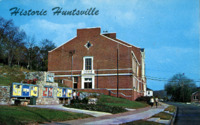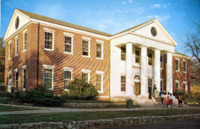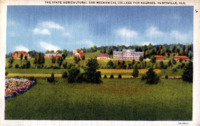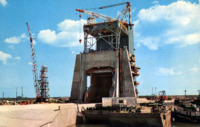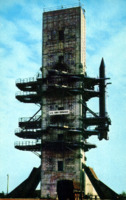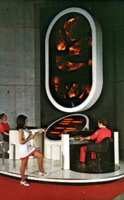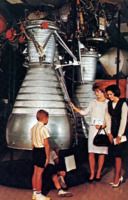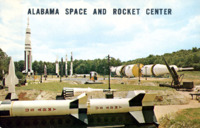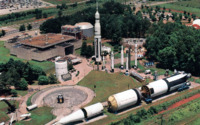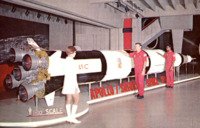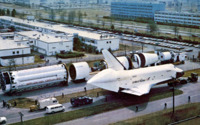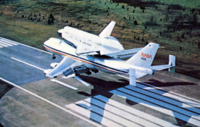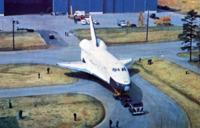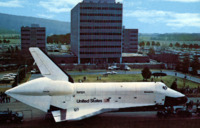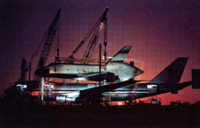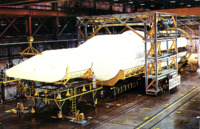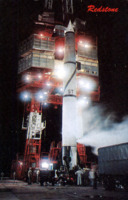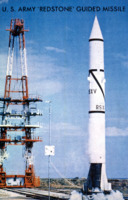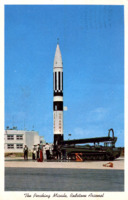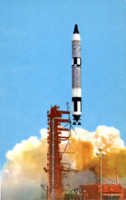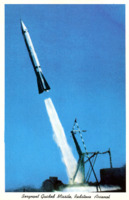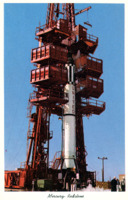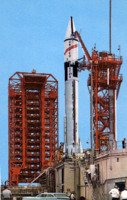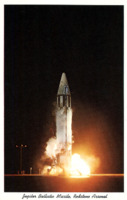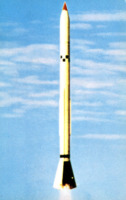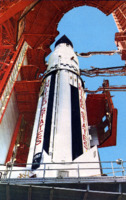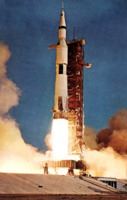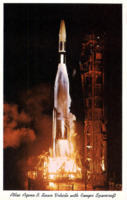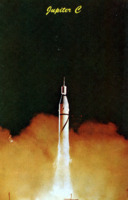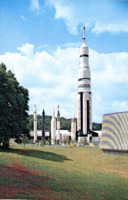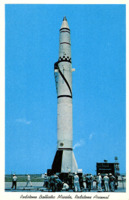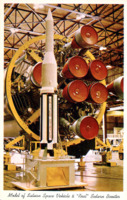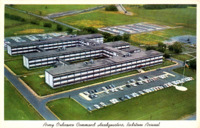
Browse Items (2055 total)
Sort by:
-
Green Bottom Inn
Front: Historic Huntsville
Back: Historic Huntsville, Alabama. ALABAMA A & M COLLEGE.
GREEN BOTTOM INN, one of Huntsville's earliest hostelries, was located on Meridian Pike on site now occupied by Alabama A & M. Built in 1815 by John Connelly, the inn attained widespread fame for its adjoining race track, over which many of the outstanding race horses of the period competed. Gen. Andrew Jackson, an avid follower of the sport, often stopped here to race his horses and fight his cocks. For many years the table where he dined was preserved. -
Carnegie Library at Alabama A & M College
Back: ALABAMA A&M COLLEGE, Normal, Alabama
Carnegie Library is a two-story brick structure of colonial design. It has a capacity of 50,000 volumes and seating space for 236. The building contains two reading rooms, a reference room, a seminar room, reference and general stacks, and an office for the staff of the library. -
"The State Agricultural and Mechanical College for Negroes"
Front: The State Agricultural and Mechanical College for Negroes, Huntsville, Ala. -
Mississippi Test Facility
Back: MISSISSIPPI TEST FACILITY, NATIONAL AERONAUTICS AND SPACE ADMINISTRATION, HANCOCK COUNTY
This 200-foot-tall rocket test tower is one of three units and this particular stand is for static firing the S-ll (second stage) of the giant Saturn V. MTF is a division of the George C. Marshall Space Flight Center, Huntsville, Alabama. -
Guided Missile Test Tower with Redstone Missile
Back: GUIDED MISSILE TEST TOWER WITH REDSTONE MISSILE, REDSTONE ARSENAL, HUNTSVILLE, ALABAMA
This is the largest static firing test stand for rocket motors in the U. S., and possibly in the world. The huge Army facility, costing $12,000,000. towers 145 feet high-as tall as a 15-story building, and is built of reinforced concrete, with walls 48 inches thick. Static testing of a missile consists in locking the missile into place on the stand and firing it. The missile does not "take off", but as it strains against the mighty grip of the great tower its roaring engine can be studied for performance characteristics as it it were actually in flight. -
Missile Strategy Computer
Back: Missile Strategy Computer is one of the many audience participation exhibits at the Alabama Space and Rocket Center. Visitors may match their skills with this highly animated exhibit highlighting the various applications of missile defense systems. The Alabama Space and Rocket Center, America's largest missile and space exhibit is located west of Huntsville, Alabama on Highway 20. -
Space Orientation Center
Back: SPACE ORIENTATION CENTER, Redstone Arsenal, Huntsville, Alabama
Unique, historically significant exhibits vividly portray the development of rocketry and space travel in the free-world missile production center. -
Alabama Space and Rocket Center
Front: ALABAMA SPACE AND ROCKET CENTER
The AIabama Space and Rocket Center contains the world's largest collection of missiles, rockets, and space vehicles. A full scale Apollo Saturn V moon rocket it exhibited in a horizontal position and it one of the featured attractions on the 35-acre complex. The exhibition Center it owned and operated by the State of Alabama and is opened every day. Located west of downtown Huntsville on Alabama Highway 20. -
Alabama Space and Rocket Center
Back: ALABAMA SPACE AND ROCKET CENTER
Earth's Largest Space Exhibit, Tranquility Base, Huntsville. Alabama 35807.
The Alabama Space and Rocket Center is the largest missile and space eihibit in the world. It was dedicated by the citizens of Alabama to those Americans who made it possible for man to walk on the moon and to explore the universe; and to the youth of America who will utilize space technology for the benefit of mankind. -
Alabama Space and Rocket Center
Back: ALABAMA SPACE AND ROCKET CENTER, Huntsville. Ala.
The Earth's Largest Space Museum offers an unrivaled display of American rocketry. The Spacedome theater and a tour of NASA's Marshall Space Flight Center complete a day of family fun and education. The center Is home of the United States Space Camp. -
Scale Model of Apollo Saturn V
Back: ALABAMA SPACE AND ROCKET CENTER, Tranquility Base, Huntsville, Alabama.
Scale model of the Apollo/Saturn V moon rocket on exhibit at the World's Largest space exhibit. -
Enterprise Passing a Saturn 1B
Back: The Old and the New, Enterprise passing a Saturn 1B. -
Preparations for Unloading Enterprise from 747 Carrier.
Back: Preparations for unloading Enterprise from 747 Carrier. -
Space Shuttle Enterprise Lands at Redstone Arsenal Airfield March 13
Back: Space Shuttle Enterprise lands at Redstone Arsenal Airfield March 13, 1978. -
Enterprise's Home for 1978
Back: Enterprise's home for 1978. -
Enterprise Passing Marshall Space Flight Center Headquarters
Back: Enterprise passing Marshall Space Flight Center Headquarters. -
Enterprise Being Unloaded from 747 Carrier
Back: Enterprise being unloaded from 747 Carrier. -
First Flight Configuration of the Saturn C-1
Back: The first flight configuration of the giant Saturn C-1 rocket is seen at the George C. Marshall Space Flight Center, N.A.S.A. Huntsville, Ala. The C-1 will be capable of placing about 10 tons into low earth orbit. -
Redstone Missile
Front: Redstone
Back: Redstone Missile. Developed at Huntsville, Alabama's Redstone Arsenal, the Redstone is shown here being readied for launching at Cape Canaveral. -
Alabama Space and Rocket Center
Back: ALABAMA SPACE AND ROCKET CENTER, Earth's Largest Space Exhibit. Tranquility Base, Huntsville. Alabama 35807.
This moon rock sample is displayed at Earth's largest space exhibit. It was collected on the moon by Apollo II astronauts. It is believed to be over 3 billion years old, and weighs 4.9 ounces. -
Saturn I Space Vehicle
Back: A Saturn I space vehicle, developed by the National Aeronautics and Space Administration's Marshall Space Flight Center. Huntsville, Ala., is launched from Cape Kennedy, Fla. The Saturn I weighs more than a million pounds at liftoff, and generates a maximum of 32,000,000 horsepower. It is a fore-runner of the Saturn V moon rocket being developed by MSFC. Huntsville. -
U.S. Army Redstone Guided Missile
Front: U. S. Army 'Redstone' Guided Missile
Back: U. S. Army 'Redstone' Guided Missile
Huntsville, Alabama, Home of Army Ballistics Missile Agency. Named after Redstone Arsenal, the Redstone is the Army's largest surface-to-surface guided missile. Capable of carrying a nuclear warhead, this weapon has proven to be very accurate at supersonic speeds. This photo is actual color made by U. S. Army. -
The Pershing Missile
Front: The Pershing Missile, Redstone Arsenal
Back: THE PERSHING MISSILE, REDSTONE ARSENAL, HUNTSVILLE, ALABAMA
This Pershing surface to surface missile can deliver an atomic warhead deep into enemy territory. The Army missile is a solid propellant ballistic missile under development by the Army Ballistic Missile Agency to replace the old reliable Redstone. The missile is named for General of the Armies John J. Pershing, World War I hero. -
Gemini - Titan I Lifting Off Launching Pad
Back: Gemini-Titan 1 lifting off launching pad on its maiden voyage, testing spacecraft and vehicle. The Gemini is the first of NASA's two-man spacecrafts. The NASA Marshall Space Flight Center at Huntsville, Alabama, has been developing and providing rockets for our space achievements since the very beginning of our entry into this field. -
Sergeant Guided Missile
Front: Sergeant Guided Missile, Redstone Arsenal.
Back: SERGEANT GUIDED MISSILE, REDSTONE ARSENAL, HUNTSVILLE, ALABAMA.
Measuring about 30 feet in length, the Army's Sergeant is a surface-to-surface, solid propellant, ballistic guided missile possessing a very high degree of reliability and accuracy. Also highly mobile, it can be quickly emplaced and fired by a very small crew, under all conditions of weather and terrain, delivering a nuclear blow far behind enomy lines. Its highly accurate guidance system is invulnerable to any known means of enemy counter-measures. -
Mercury Redstone
Front: Mercury Redstone
Back: National Aeronautics and Space Administration's "Mercury-Redstone" being readied for launch at the Cape Kennedy launch site. The rocket was provided by the NASA George C. Marshall Space Flight Center, Huntsville, Alabama. -
Centaur II undergoes pre-launch tests
Back: Centaur II, our first space vehicle to use liquid hydrogen as a propellent, undergoes pre-launch tests.
The NASA Marshall Space Flight Center at Huntsville, Alabama, has been developing and providing rockets for our space achievements since the very beginning of our entry into this field. -
Jupiter Ballistic Missile
Front: Jupiter Ballistic Missile, Redstone Arsenal
Back: JUPITER BALLISTIC MISSILE, REDSTONE ARSENAL, HUNTSVILLE, ALABAMA
The largest weapon, for which the Army has development responsibility, the Jupiter has pin-point accuracy against targets at ranges up to 1,500 nautical miles. The missile is 58 feet in length, and 105 inches in diameter. -
Corporal Guided Missile
Back: CORPORAL GUIDED MISSILE REDSTONE ARSENAL, HUNTSVILLE, ALABAMA
A member of the Army missile family used in support of ground combat operations, the Corporal, equipped with either an atomic or conventional type warhead, is a surface-to-surface guided missile capable of engaging tactical targets far beyond the range of conventional artillery. A powerful rocket motor propels the missile through space, at several times the speed of sound. -
"NASA'S SA-5 undergoing pre-lounch check-out."
Back: NASA'S SA-5 undergoing pre-launch check-out. The Saturn is the free-world's largest space booster. It develops a million and a half pounds thrust. The NASA Marshall Space Flight Center at Huntsville. Alabama, has been developing and providing rockets for our space achievements since the very beginning of our entry into this field. -
Saturn V Launch
Back: This Is the National Aeronautics and Space Administration's Apollo/Saturn V vehicle, used to place man on the moon. The Saturn V vehicle, developing 7.6 million pounds thrust, was developed under the direction of the NASA-Marshall Space Flight Center, Huntsville, Ala. -
Atlas Agena-B Space Vehicle with Range Spacecraft
Front: Atlas Agena-B Space Vehicle with Ranger Spacecraft
Back: ATLAS AGENA-B SPACE VEHICLE WITH RANGER SPACECRAFT
The Atlas Agena-B space vehicle it shown here with its Ranger spacecraft payload on the pad at Cape Canaveral. Fla. The Atlas Agena-B is being used by NASA to launch the 750-pound Ranger lunar impact missions. The Atlas Agena-B program is managed by the NASA Marshall Space Flight Center, Huntsville, Alabama. -
Juno II with Pioneer IV
Front: Juno II, with Pioneer IV, Redstone Arsenal
Back: JUNO II. WITH PIONEER IV, REDSTONE ARSENAL, HUNTSVILLE. ALABAMA
This space-probing vehicle became the first made-in-the-U.S.A. satellite of the sun. Just 40 hours after launching, Pioneer IV sped past the moon and continued on its journey to the sun. Signals were received until it reached a distance of 416,000 miles - farther than any other man-made object had been tracked. -
Jupiter C
Front: Jupiter C
Back: JUPITER-C. Huntsville, Ala. This missile was developed in Huntsville, Ala. at the Redstone Arsenal, home of the Army Ballistic Missile Agency. -
Alabama Space and Rocket Center
Back: ALABAMA SPACE AND ROCKET CENTER
America's Largest Missile and Space Exhibit, Tranquility Base Huntsville, Alabama 35807.
The Alabama Space and Rocket Center is the largest missile and space exhibit in the world. It was dedicated by the citizens of Alabama to those Americans who made it possible for man to walk on the moon and to explore the universe; and to the youth of America who will utilize space technology for the benefit of mankind. -
Redstone Ballistic Missile
Front: Redstone Ballistic Missile, Redstone Arsenal
Back: REDSTONE BALLISTIC MISSILE REDSTONE ARSENAL, HUNTSVILLE. ALABAMA
The Army's "Sunday Punch", the Redstone, is a liquid-propelled, surface-to-surface ballistic missile, which can place a nuclear or conventional warhead, with extreme accuracy, on targets up to 200 miles away. The missile is 69 feet long and 70 inches in diameter. -
Space Vehicle - Made in Huntsville
Front: Saturn Space Vehicle - Made in Huntsville, Alabama.
Back: NATIONAL AERONAUTICS AND SPACE ADMINISTRATION'S "SATURN" - WORLD'S LARGEST KNOWN ROCKET LAUNCHED FROM CAPE CANAVERAL, FLORIDA ON OCTOBER 27, 1961. -
Model of Saturn Space Vehicle & "Real" Saturn Booster
Front: Model of Saturn Space Vehicle & "Real" Saturn Booster.
Back: SCALE MODEL, SATURN SPACE VEHICLE AND "REAL" SATURN BOOSTER
A one-tenth scale model of the Saturn Space vehicle is shown here behind a "real" Saturn booster at the assembly area of the NASA Marshall Space Flight Center, Huntsville, Alabama. The big booster is capable of developing 1.5 million pounds thrust. An assembled vehicle stands 162 feet high. -
Nike-Ajax Guided Missile
Front: Nike-Ajax Guided Missile, Redstone Arsenal
Back: NIKE-AJAX GUIDED MISSILE, REDSTONE ARSENAL, HUNTSVILLE, ALABAMA
The Army's first supersonic anti-aircraft guided missile designed to follow and destroy the enemy target, regardless of evasive action. The Nike-Ajax system consists essentially of two parts First, an expendable missile; second, an elaborate and highly complex control system requiring approximately 1,400,000 individual parts. It is the first guided missile system to defend American cities against attack. -
Army Ordnance Command Headquarters, Redstone Arsenal
Front: Army Ordnance Command Headquarters, Redstone Arsenal
Back: THE U. S. ARMY MISSILE COMMAND HEADQUARTERS, REDSTONE ARSENAL, ALABAMA
The Missle Command is responsible for research, design, development, production, maintenance and supply of all Army missiles and rockets. It is a military-civilian team that has pushed the art of missilery rapidly forward. People are the Command's primary resource and their brains and ability are its most precious asset.
